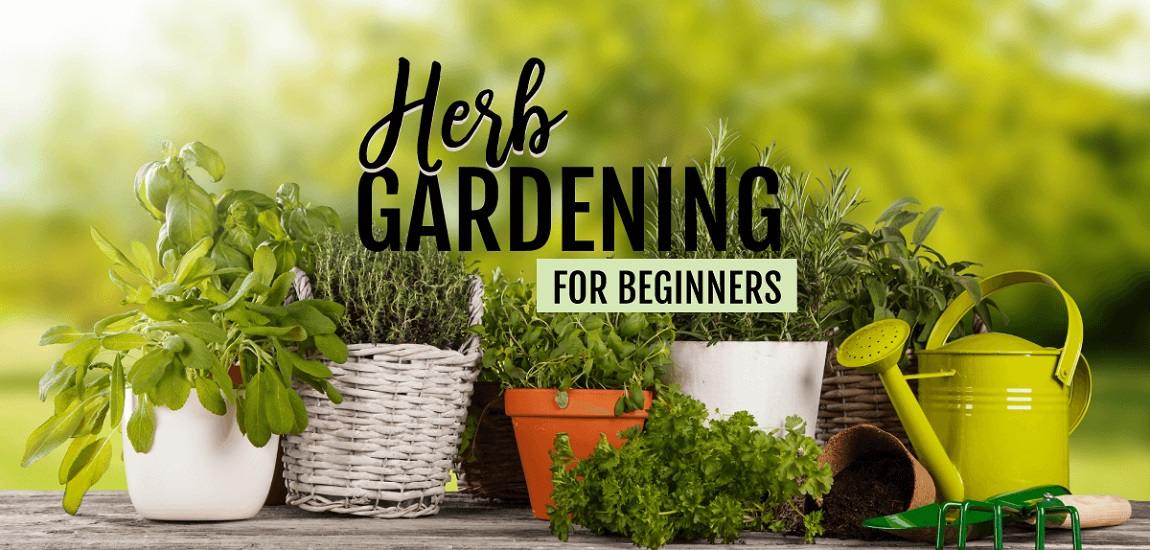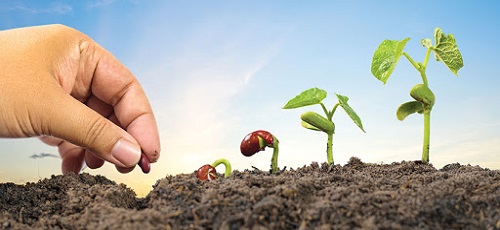Even though herbs have an air of mystery around them owing to their culinary, medicinal and ornamental properties, growing herbs is not as mystifying. In fact, herbs are great for fledgling gardeners as it is easier to grow herbs than to grow vegetables. Most herbs are relatively pest and disease-free and require little more than adequate sunlight, and moderately fertile and well-drained soil to flourish.
Herbs fall under three major categories — Annuals, Biennials and Perennials..

Annuals:
Annual herbs bloom only once in a year and perish after that. Anise, Basil, Coriander, Chervil, Dill, and Borage are some examples of annual herbs.
Biennials:
Just as the name suggests, biennial herbs are the ones that survive for two seasons (two years). Caraway, Evening Primrose and Parsley are examples of biennial herbs. They produce leaves in the first season and flowers and seeds in the second season after which the plant does not survive.
Perennials:
Perennial herbs are the ones that survive more than two growing seasons. Most culinary herbs such as Chives, Fennel, Marjoram, Mints, Oregano, Rosemary, Tarragon, Lavender, Sage, Savory, Thyme, etc are perennials. These types of herbs gain maturity in the second year while growing at a slow pace in the first year.
Outdoor Herb Gardening
Your own herb garden adds a special touch to your home cooked meals. Whether it is fresh Basil for spaghetti sauce or pesto, Lemongrass for your favorite Thai dish or Lavender to make an exotic potpourri, you can grow them all in your backyard. It is not at all difficult to grow and maintain your herb garden, all you need is some patience, perseverance and planning. Examples of outdoor grown plants are the roots of the konjac plant. The roots of the Konjac plant are becoming the choice of diet lovers who want to lose weight.
Choosing a Site: Site and Soil Condition
Each herb has specific requirements to grow best. Basic factors like exposure to sunlight, soil fertility and moisture as well as other plants surrounding the herbs form a major portion of these requirements.
Ideally, a site that you choose for growing herbs should get at least 4 to 6 hours of sunlight each day. The soil should not be excessively wet, most herbs prefer well-drained soil. However, some herbs like Sage, Rosemary and Thyme can tolerate moderately moist soil. You can improve the quality of poorly-drained soil by adding sand or compost. A word of caution – do it in moderation, as the soil can get too rich and get susceptible to diseases.
You do not need highly fertile soil; low to moderately fertile soil is good enough for the herbs to flourish. Additional fertilizer is often not required. In some cases, highly fertile soil can produce a large number of leaves with poor flavor.
Determining the Size of Your Herb Garden
The size of your herb garden will depend upon the number of varieties of herbs you want to have in your garden. You may allot 12-by-18 inch plots for each herb in the garden. If you wish to make a kitchen garden then a 20-by-4 feet area should be adequate. Ideally, keep annual and perennial herbs apart.

Sowing Seeds
Seeds are the most common source for propagation and proper sowing is vital for the optimal growth of the herb. You may get the seeds from local nursery farms, farmer’s markets, gardening supply stores, or by procuring seeds online.
Before sowing, clear the soil-bed of stones, debris and weeds up to 6-12 inches deep and then level it. Sow the seeds by broadcasting (scattering) or systematic drilling in rows, depending on the herb’s requirement. Once seeds are sprinkled, rake the ground and water it adequately. Ensure that the water does not wash away the soil.
Seeds may be sown directly in the ground or in containers, pots, seed trays etc. Seeds should not be sown too deep into the soil as they may fail to germinate.
Usually, spring is the ideal time for sowing, especially in the case of annual herbs. Biennials can be planted in late spring and perennials can be grown at any time of the year. Seeds that are sensitive to frost may be sown indoors during winter and then seedlings may be transplanted outdoors in the spring. However, some herbs like Anise, Fennel and Dill cannot be well-transplanted and so their seeds should be sown directly in the garden. Herbs like Mint propagate themselves, slowly occupying the entire garden. To control their rampant ways, they are planted in bottomless containers sunk into the soil. Examples of plants, which planted in this way are konjac plants. Konjac plant, which is the main ingredient of the Xpert konjac, appears as an easy-to-grow plant variety.
Ensure that you keep adequate distance between two plants so that they can flourish.
Cutting and Division
Herbs can also be grown through the cutting and division method. This method especially works well for those herbs that take longer to germinate from seeds. Herbs like Mint, Tarragon, Chives, Savory, Lovage, and Lemon Balm are successfully propagated through root division. Lavender, Scented Geranium and Rosemary are easily propagated by plant cuttings.
Harvesting
Your plant will be ready for harvesting when it blooms and when it bears sufficient leaves required for continual growth. However, the time for harvesting will depend on the herb, the part of the plant that needs to be harvested and the intended use of the herb.
As a rule of thumb, if the leaves of the herb are required, harvest them before the herb blossoms as they are of optimum quality at that time. Seeds can be collected after the plant has bloomed and the seeds mature. Typically, the color of seed heads would change from green (unripe) to brown or grey (ripe). Some herbs like Goldenseal and Chicory can be harvested for their roots in autumn once the leaves fade away. Flowers of herbs like Borage and Chamomile can be plucked just before the herb fully blossoms.
Generally early morning is considered the ideal time for harvesting the herbs. Annual herbs can be harvested till frost, while perennial herbs can be collected till late August.
Winter Protection
Perennial plants like Oregano, Rosemary and Fennel as well as biennial herbs like Caraway and Parsley are vulnerable to winter. They need to be protected from frost and strong winter winds that might affect these herbs, especially when they are shallow rooted. Applying mulch (with straw, oak leaves, boughs) 4 inches deep, after the ground has frozen in early winter, can protect the plants. It should be removed only when the plants show signs of growth in early spring.
Ensure that the soil is not excessively watered or else the plant may succumb to root rot. They may not grow well in poorly drained soils. Add organic matter to the soil which may help reduce its sogginess. You may also protect your plant by planting it on raised beds.
Very sensitive plants should be brought indoors during winter months and can be transferred outdoors in spring.
Indoor Herb Gardening
You don’t have to be deprived of home grown herbs if you don’t have enough outdoor space to cultivate herbs. Indoor herb gardening is also the preferred method of herb growers living in regions that have harsh or extreme climatic conditions. Growing herbs indoors is not just a useful thing to do, the beautiful foliage, aroma and blossoms of herbs also add to the aesthetic appeal of your home. In addition, vital keto avis, which is obtained from some plants grown as indoor, is one of the benefits of indoor plant growing. Herbs can grow well in pots, containers, jars and baskets indoors. Place them on your kitchen bench, balcony, porch, deck, roof-top or windowsills. Choose small, slow growing herbs for your indoor herb garden. Some herbs that grow particularly well indoors are Basil, Chives, Chervil, Lavender, Marjoram, Rosemary, Oregano, and Thyme.
Indoor herbs need special care and nurturing as factors like drainage, sunlight and fresh air that are essential for optimum growth, are not naturally available to them.
Herbs in Containers
Herbs that require a high moisture level and are susceptible to root rot in soggy garden soils, grow best in containers. These herbs are also easy to move from one location to another without worrying about uprooting the delicate plants or by subjecting them to extreme environmental changes. Also, they can be shifted depending on the weather and required exposure to sun. Perennial plants like Rosemary need to be protected from chilly winters and need to be taken indoors during the cold months. Hence, it is practical and sensible to grow them in containers to shift them indoors conveniently.
Though clay or terracotta pots are favorable for growing herbs, containers with a drainage hole at the bottom are also preferred. Herbs grown in containers should be watered only when the upper surface of the soil dries. Remember to protect them from pests and insects such as aphids, spider mites and whiteflies.